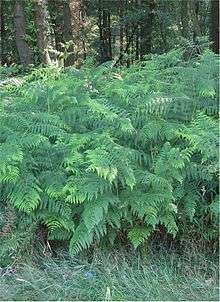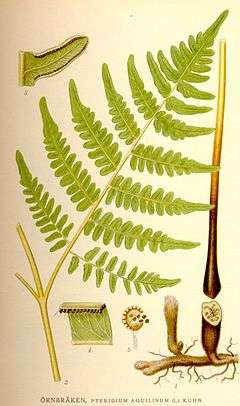Pteridium aquilinum
| Pteridium aquilinum | |
|---|---|
 | |
| Scientific classification | |
| Kingdom: | Plantae |
| Division: | Pteridophyta |
| Class: | Pteridopsida |
| Order: | Dennstaedtiales |
| Family: | Dennstaedtiaceae |
| Genus: | Pteridium |
| Species: | P. aquilinum |
| Binomial name | |
| Pteridium aquilinum (L.) Kuhn | |

Pteridium aquilinum (bracken, brake or common bracken), also known as eagle fern, is a species of fern occurring in temperate and subtropical regions in both hemispheres. The extreme lightness of its spores has led to its global distribution.
Common bracken was first described as Pteris aquilina by the father of taxonomy, Carl Linnaeus, in Volume 2 of his Species Plantarum in 1753. The origin of the specific epithet derived from the Latin aquila "eagle", but what it pertains to has been a matter of some debate. It is generally held to be the shape of the mature fronds appearing akin to an eagle's wing.[1] However, medieval scholars, including Erasmus, thought the pattern of the fibres seen in a transverse section of the stipe resembled a double-headed eagle or oak tree. It was given its current binomial name by Friedrich Adalbert Maximilian Kuhn in 1879.[2]
It was traditionally treated as the sole species in the genus Pteridium (brackens); authorities have split and recognised up to 11 species in the genus, however.
Common bracken is a herbaceous perennial plant, deciduous in winter. The large, roughly triangular fronds are produced singly, arising upwards from an underground rhizome, and grow to 1–3 m (3–10 ft) tall; the main stem, or stipe, is up to 1 cm (0.4 in) diameter at the base.
An adaptable plant, bracken readily colonises disturbed areas. It can even be aggressive in countries where it is native, such as England, where it has invaded heather (Calluna vulgaris (L.) Hull) stands on the North Yorkshire moors.[3]
The plant contains the carcinogenic compound ptaquiloside,[4] and communities (mainly in Japan) where the young stems are used as a vegetable have some of the highest stomach cancer rates in the world.[5] Consumption of ptaquiloside-contaminated milk is thought to contribute to human gastric cancer in the Andean states of Venezuela.[6]
The spores have also been implicated as carcinogens.
It has been suggested that selenium supplementation can prevent as well as reverse the immunotoxic effects induced by ptaquiloside from Pteridium aquilinum.[7]
References
- ↑ Austin, Daniel F. (2004). Florida ethnobotany. CRC Press. p. 551. ISBN 0-8493-2332-0. Retrieved 30 June 2010.
- ↑ Thomson, John A. (2004). "Towards a taxonomic revision of Pteridium (Dennstaedtiaceae).". Telopea. 10 (4): 793–803.
- ↑ Whitehead SJ, Digby J (1997). "The morphology of bracken (Pteridium aquilinum (L.) Kuhn) in the North York Moors—a comparison of the mature stand and the interface with heather (Calluna vulgaris (L.) Hull) 1. The fronds". Annals of Applied Biology. 131 (1): 103–16. doi:10.1111/j.1744-7348.1997.tb05399.x.
- ↑ Gomes J, Magalhães A, Michel V, Amado I, Aranha P, Ovesen RG, Hansen HC, Gärtner F, Reis CA, Touati E.,"Pteridium aquilinum and its ptaquiloside toxin induce DNA damage response in gastric epithelial cells, a link with gastric carcinogenesis". Toxicol Sci. 2011 Dec 5;
- ↑ I A Evans; B Widdop; R S Jones; G D Barber; H Leach; D L Jones & R Mainwaring-Burton (1971). "The possible human hazard of the naturally occurring bracken carcinogen". Biochem J. 124 (2): 29P–30P. PMC 1177200
 . PMID 5158492.
. PMID 5158492. - ↑ Alonso-Amelot M.E., Avendano M. "Possible association between gastric cancer and bracken fern in Venezuela: An epidemiologic study." International Journal of Cancer. 91 (2) (pp 252-259), 2001.
- ↑ Latorre A.O., Caniceiro B.D., Wysocki H.L., Haraguchi M., Gardner D.R., Gorniak S.L.,"Selenium reverses Pteridium aquilinum-induced immunotoxic effects. Food and Chemical Toxicology. 49 (2) (pp 464-470), 2011
External links
- Germplasm Resources Information Network: Pteridium aquilinum
- Flora Europaea: Pteridium aquilinum
- Flora of North America: Pteridium aquilinum